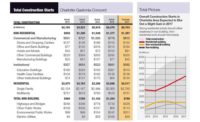To prevent a protracted construction process that would frustrate both motorists and business owners, the construction teams revamped their schedules as utility relocation work was completed. Teams combined what had originally been planned as linear phases into concurrent operations, such as widening the northbound and southbound sides of the highway concurrently rather than one at a time.
Brian Stover, project director for HNTB, which is managing construction services for CATS's Blue Line Extension, says consolidating those tasks helped make up some time, cutting three to four months off the original construction schedule.
"The business owners still had to deal with a lot of activity in front of their locations, but it was completed sooner," Stover says. He notes that the use of tablets equipped with construction management software was essential in keeping the field supervisors up to date with the frequent plan and schedule revisions.
Public outreach likewise played a critical role. "Part of creating sustainable development going forward is protecting what's already there," Rogers says. "You don't want the cure to be part of the illness. We had a dedicated team working to help keep the businesses visible, and alert them to what would be happening in the coming weeks so that they could prepare."
The relocation roles were somewhat reversed for building the extension's four-mile route through the Norfolk Southern-owned rail corridor, which includes as many as four tracks shared by six railroads. With CATS responsible for relocating the existing tracks to make room for the light rail line, "we're essentially working for the railroad," Rogers explains.
That made coordinating construction activity with both freight and passenger railroad operations especially critical.
"We had to figure out how to do as much as possible safely within tight windows of only a few hours," Stover says. "It hasn't been easy, but we've been able to do it."
More problematic, however, has been the project area's pervasive shallow depth rock. Conditions complicated the construction of foundations for three straddle bents and two hammerhead bents, supporting a 735-ft-long, 713-ton steel bridge that lifts the light rail line over the rail tracks and a cross street. In addition to the time-consuming process of drilling 8-ft-dia shafts 80 to 100 ft deep, frequent encounters with subsurface water created the risk of cave-ins. This required the use of temporary casings that were removed as concrete was poured.
"That's pushed the schedule out, so we had to take as much of the drilled shaft work as possible off critical path," Stover says.
Other structures along the Blue Line Extension have proven somewhat less complicated. The 447-ft, three-span curved steel girder bridge that brings the light rail line into the center of Tryon Avenue includes some of the project's 184,630 sq ft of mechanically stabilized earth (MSE) retaining walls. These were fitted with precast panels and cast-in-place textured form lines, which feature patterns of native plants.
To bring the Blue Line Extension onto the UNCC campus, Lane is constructing a 40-ft-deep, 340-ft-long, cut-and-cover underpass beneath Tryon Avenue's northbound lanes that will include a 23-ft by 36-ft cast-in-place box culvert structure, reinforced with one-sided wall formwork and permanent soil nail walls. From there, the 822-ft-long, 11-span precast Toby Creek Viaduct with pre-stressed supports will convey the Blue Line Extension across a wetland to the terminus station.








Post a comment to this article
Report Abusive Comment